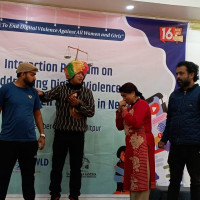- Wednesday, 26 November 2025
Misleading Information About Gorkhapatra
The publication of 'Gorkhapatra' was a historic moment in Nepal's journalism and the beginning of shaping global journalism ethics.
The sister publication of the country's first broadsheet English daily, 'Rising Nepal', and Gorkhapatra holds the title of the country's newspaper. It is celebrating its 125th anniversary today. Published in Nepali, Gorkhapatra began as a weekly newspaper on May 6, 1901, and became a daily on February 18, 1961. In the years between, it was published twice and three times a week.
Although a few periodicals, including 'Sharada', 'Udyog', 'Sahityashrota', and 'Gharelu Ilama Patrika', were published, another newspaper publication took more than the next five decades. 'Jagaran' weekly, a newspaper with a political perspective, was launched on February 15, 1951, three days before the royal proclamation. 'Aawaj', another newspaper, was launched on February 19, 1951, the next day after the royal proclamation. King Tribhuvan formally declared an end to the Rana family's 104-year ruling and his wish to create a democratic constitution for Nepal on February 18, 1951.
Jagaran and Awaj survived only for a short period. However, a change in the political system paved the way for newspaper publication in the country. In the following days, many other newspapers were published despite various obstacles. But Gorkhapatra remained a synonym for newspaper among Nepali people for a long time.
Misleading information about Gorkhapatra can be found in books and journals published within the country and abroad. Such information ultimately distorts Nepal's journalism history. The purpose of this writing is to shed light on some such misinformation.
The issuing date of Sanad, a government order concerned with the arrangement of works to be done or not to be done, is one of them. Prime Minister Dev Shumsher issued the Sanad for Gorkhapatra publication in 1901.
In a book entitled 'Global Perspectives on Journalism in Nepal: Nepalese News Media in the Twenty-First Century', published by Routledge in 2022, it is stated that the Sanad was issued on April 23, 1901. This information is misleading.
Another book entitled 'Aamsanchar ra Kanoon' (Mass Communication and Law), published by Nepal Press Institute in 2002, states that the Sanad was issued in 1958 BS Baishakh 11 Roj (day) 2. This, too, is misleading information. One vital clue or word, 'Vadi', is missing on the given date, which has created confusion and ultimately resulted in the error. The terms Sudi and Vadi indicate that the date is based on the lunar calendar.
The Sanatan Hindu lunar calendar system divides months into two fortnights: Shukla Paksha (waxing phase) and Krishna Paksha (waning phase). Sudi denotes the Shukla Paksha, and Vadi denotes the Krishna Paksha.
Some other books and individual articles have mentioned 1958 BS Baishakh 11 as the Sanad issuing date. The full text of the Sanad is given in a book entitled 'Nepalko Chhapakhana ra Patrapatrikako Itihas' (History of Nepal's Printing Press and Newspapers), published by Sajha Prakashan in 1994. The book mentions that the Sanad was issued in 1958, Baishakh Vadi 11 Roj (day) 2. The term Vadi clarifies that the date is based on the lunar calendar. According to the solar calendar system, it is Monday, Baishakh 3, 1958 BS (April 15, 1901). The term Roj 2 denotes the second day of the week.
Another confusing information is the label tagged with Gorkhapatra. In 'Newspapers in Asia: Contemporary Trends and Problems', published by Heinemann Asia in 1982, it is stated: "… the government started Gorkhapatra as a literary weekly." The assertion in the 2000 Sage publication, Handbook of the Media in Asia, regarding the Gorkhapatra's origins as a literary weekly lacks evidentiary support, including that from the Sanad and early editions.
Undoubtedly, one of the exemplary works done by Gorkhapatra is its contribution to developing Nepali literature. Novels, stories, poems, essays, biographies, travelogues, plays, etc., were published. It does not mean that it was a literary periodical.
Scholarly writers have also been found making mistakes or getting confused while writing the date of publication of the Gorkhapatra, which ultimately makes the history of the publication misleading. 'Nepal's Mass Media' was published by the then Department of Information in July 1983. The publication stated that the paper was published on Baishakh 24, 1954 Bikram Era, corresponding to April 1901. The mistake on the given date might be because of a typographic error or proof, but there is no doubt that it was and is a mistake.
Similarly, in 'Tyati Belako Patrakarita' (Journalism at that time), published by Pairavi Book House in 2065 BS (2008-09 AD), in 'Bidhagata Patrakarita Hate Pustak' (Beat Journalism Handbook), published by the Office of the Communication Registrar, Government of Bagmati Province, in July 2023, and in an article entitled 'Nepalma Chhapa Patrakarita' (Print Journalism in Nepal) in a journalism special issue of Nepal bi-monthly published by the Department of Information and Broadcasting in 2000 AD has been stated that the Gorkhapatra was first published on '3rd Jestha, 1958' BS. It corresponds to May 16, 1901.
The fact is that the first issue of Gorkhapatra was published on 24 Baishakh, 1958 (solar calendar system), alias Sambat 1958 Jestha Vadi 3 (lunar calendar system), alias May 6, 1901 (Gregorian calendar system).
Information regarding the paper that pioneered journalism in Nepal is also false. Credit is given to Sudhasagar for pioneering journalism in Nepal. Among the periodicals printed and published in Nepal, Sudhasagar is considered the first. It is said that it began publishing in Shrawan 1955 BS (July/August 1898).
There is no documentation of Sudhasagar's existence in private or national archives; its publication run and specific characteristics remain undetermined. Sources uniformly classify it as a monthly literary magazine, not a newspaper. A basic definition of journalism is the practice of gathering, assessing, creating, and presenting news and information to the public. Only those journalism periodicals that practice journalism, focusing on reporting, analyzing, and presenting information with accuracy and objectivity, following journalistic norms and principles, adhering to journalistic ethics, and so on, are considered journalism. So, a narrative describing Sudhasagar as the first newspaper published in Nepal is misleading.
The Gorkhapatra is one of the few surviving newspapers in the world, with a publication history of 125 years. The Sanad issued for the publication of the Gorkhapatra had a list of 'chhapne' (print) and 'nachhapne' (do not print) regarding the matters to be published. Prakash Wasti (1953-2024), a former justice of the Supreme Court, describes the Sanad as the first press law of the country in a book entitled 'Hamro Kanun Ithihasako Nalibeli' (A Complete Description of Our Legal History).
The 'print' and 'do not print' lists of the Sanad also deal with ethical issues. The pioneering role it played in making journalism ethics is noteworthy. Two decades later, the American Society of Newspaper Editors adopted the Canons of Journalism on April 23, 1923. The Society of Professional Journalists adopted its first Code of Ethics in 1960. If journalism is the first draft of history, Gorkhapatra is a vast repository of such drafts that have yet to be put to good use.
There may be some shortcomings of Gorkhapatra, but spreading misleading information is unacceptable. The academic world should be vigilant in preventing the spread of misleading information on any subject, not just Gorkhapatra.
(Shrestha is a former chief editor of Gorkhapatra daily.)

















